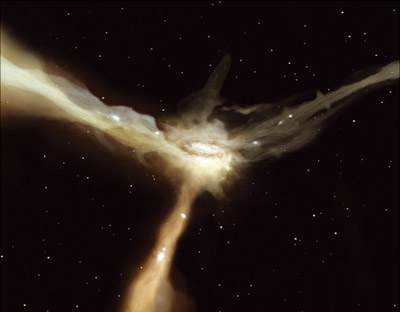
Artist’s impression of a galaxy with gentle, steady star formation supplied by rapid, narrow streams of cold gas.
Image credit: ESA/AOES Medialab.
Did most galaxies form their stars through violent and tumultuous merging events or via more steady and gentle processes? A study of deep-field observations by the Herschel Space Observatory favours a quiet build-up for most galaxies, which is in contradiction with preconceptions.
The Herschel and Planck missions of the European Space Agency were launched together by an Ariane 5 rocket on 14 May 2009 (CERN Courier July/August 2009 p12). While Planck is scanning the whole sky with its prime objective to study the cosmic microwave background, conversely Herschel is performing accurate, deep observations of specific regions of the sky. Named after William Herschel, who discovered infrared radiation in 1800, it observes a variety of far-infrared sources – from the formation of stars and planets in the Milky Way to faint galaxies in the distant universe (CERN Courier September 2010 p11).
There are basically two routes to star formation: one involves a rather slow and steady process in spiral galaxies; the other is via short-lived starbursts that are thought to be driven by the interactions and mergers of galaxies. Starburst galaxies are known to be more frequent in the early universe and – with their stronger star formation rate (SFR) – they are thought to be prime contributors to the build-up of the stellar content of galaxies. The Herschel mission offers an unrivalled opportunity to test this hypothesis by determining the relative contribution of the two modes to the global SFR of the universe.
To have a statistically significant sample of galaxies over a broad range of distances Herschel turned its 3.5-m mirror – the largest space telescope – to fields already observed by the Hubble Space Telescope and other facilities, namely the northern and southern fields of the Great Observatories Origins Deep Survey (GOODS) and the wider COSMOS (Cosmic Evolution Survey) field. The GOODS-North and GOODS-South fields each cover a region of about 10 × 15 arcminutes (around a quarter of the size of the full moon), whereas the COSMOS field of 2° square is 50 times larger.
A first study by David Elbaz from CEA Saclay and colleagues from Europe and America has investigated the SFR in more than 2000 galaxies that were identified in the GOODS fields. These were found to have surprisingly similar infrared properties despite spanning the past 11 billion years, or 80% of the history of the universe. Starburst galaxies can be identified as outliers with a relative deficit of emission at a wavelength of about 8 μm. The origin of the difference would lie in the destruction of 8-μm emitting molecules – known as polycyclic aromatic hydrocarbons – by UV radiation in galaxies with compact starburst regions.
Elbaz and colleagues find that starburst galaxies contribute only about 20% to star formation in the universe. The result is corroborated by a second study led by Giulia Rodighiero of the University of Padova and European colleagues, which concentrated on the cosmic peak of the star-formation activity about 10 billion years ago – at a redshift of around z = 2 – using the GOODS-South and the wide COSMOS fields.
This evidence that most galaxies in the universe formed their stars in a gentle and steady fashion triggers a new question: how could such a process be more efficient in the early universe than now? A possible solution is that early galaxies are fed by rapid, narrow streams of cold gas, providing them with continuous flows of raw material for star formation. This scenario has not yet been observed but is suggested by computer simulations in which massive galaxies form in the knots of the cosmic web of dark matter and gas filaments that pervades the universe (CERN Courier September 2007 p11).





